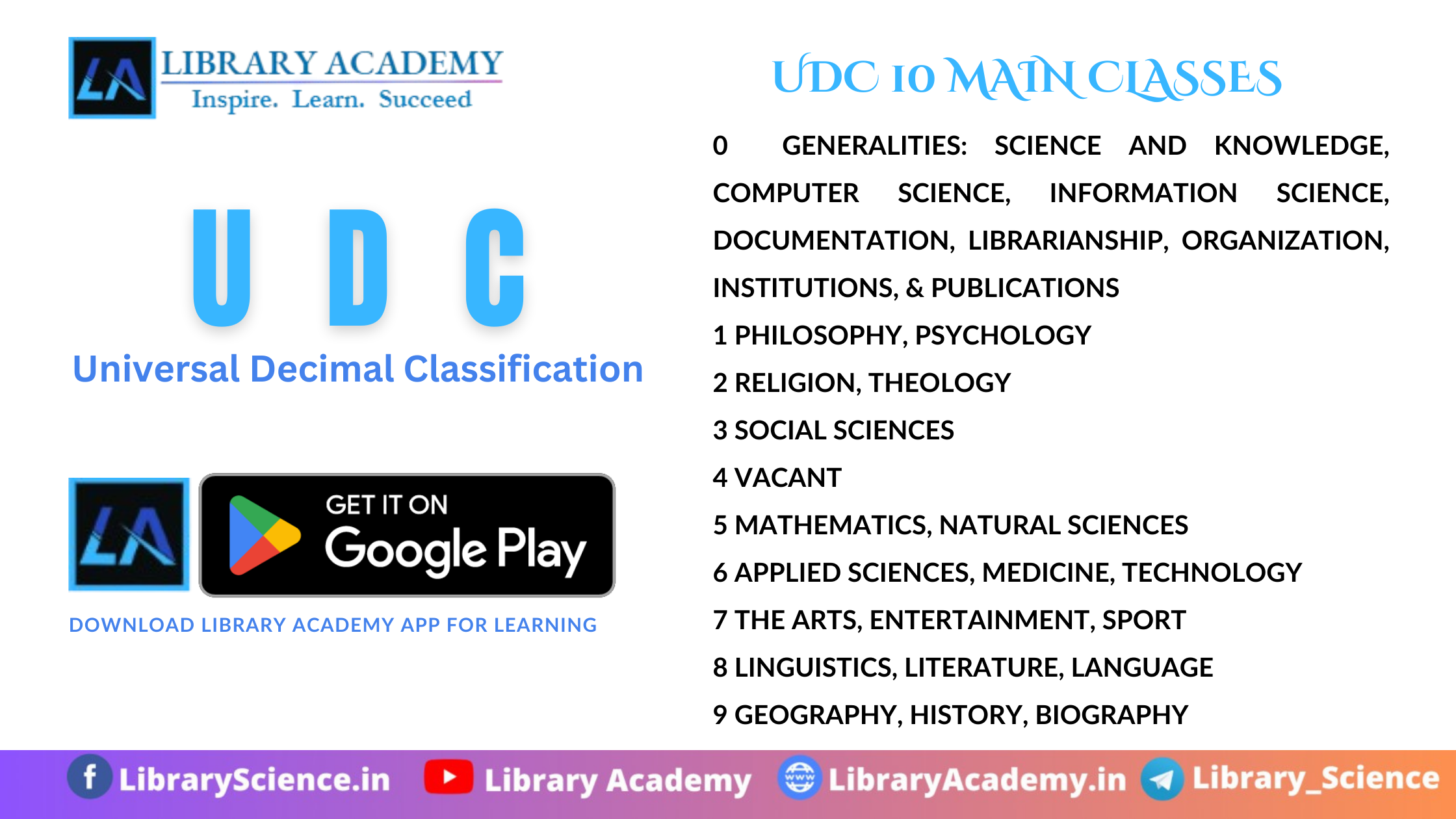Universal Decimal Classification (UDC) is a structured bibliographic and library classification system that organizes all branches of human knowledge. UDC is an analytico-synthetic and/or faceted classification.
NIScPR Online Periodicals Repository is managed with the help of UDC Classification System & Its also called European Dewey, Brussels Classification, and International decimal classification. Being based on the Dewey’s System.
Universal Decimal Classification (UDC): A Global Knowledge Organization System
The Universal Decimal Classification (UDC) is a powerful tool employed by bibliographic services, documentation centers, and libraries across approximately 130 countries worldwide. For over a century, this indexing system has facilitated the organization and retrieval of information, though providing an accurate account of its use globally is challenging.
Here are some key points about UDC:
- Origin and Development: In 1885, Paul Otlet and Henry La Fontaine were working on the projected Universal Bibliographic Repertory, UDC was developed from the Dewey Decimal Classification (DDC) system and was first introduced in 1905. It was designed to address the limitations of the DDC and provide a more detailed and flexible system for organizing knowledge.
- Main Classes of UDC or UDC Tables: UDC main Classes are also called the “schedules”, these contain the outline of the disciplines of knowledge, arranged in 10 main classes and hierarchically divided. UDC Main Classes are numbered from 0 to 9.
UDC 10 Main Classes: UDC Main Classes are Numbered from 0 to 9.
Notation Description
0 Generalities: Science and Knowledge, Computer Science, Information Science, Documentation, Librarianship, Organization, Institutions, & Publications
1 Philosophy, Psychology
2 Religion, Theology
3 Social Sciences
4 vacant
5 Mathematics, Natural Sciences
6 Applied Sciences, Medicine, Technology
7 The Arts, Entertainment, Sport
8 Linguistics, Literature, Language
9 Geography, History, Biography
- UDC Special Auxiliaries: Each UDC main class may also contain tables called special auxiliaries. Special auxiliary numbers are easily recognizable as they begin with one of three specific symbols or indicators:
- .0 (point nought)
- – (hyphen)
- ‘ (apostrophe)
Any UDC number starting with one of these symbols can be combined with any other UDC number within its designated area of application. This allows for a flexible and precise way to classify and index detailed aspects of knowledge within the UDC system.
Common auxiliary tables: Common auxiliary tables contain common auxiliary signs and common auxiliary numbers.
Common Auxiliary Signs: The signs (e.g. the plus, the stroke, the colon) are used to link two (or more) numbers, so expressing relations of various kinds between two (or more) subjects.These signs are used to represent recurrent aspects that apply across various subjects. They enhance the flexibility and precision of the UDC system by allowing combinations with other UDC numbers.
Notation Description
+ Coordination. Addition (plus sign). Table 1a
/ Consecutive extension (oblique stroke sign). Table 1a
: Simple relation (colon sign). Table 1b
:: Order-fixing (double colon sign). Table 1b
[] Subgrouping (square brackets). Table 1b
* Introduces non-UDC notation (asterisk). Table 1h
A/Z Direct alphabetical specification. Table 1h
Common Auxiliary Numbers: Below are tables listing recurring characteristics that apply across various subjects. The auxiliary is added at the end of each subject number. Common auxiliaries are utilized throughout the main tables and denote concepts such as place, language of the text, and physical form of the document, which are relevant to nearly any subject.
Notation Description
=… Common auxiliaries of language. Table 1c
(0…) Common auxiliaries of form. Table 1d
(1/9) Common auxiliaries of place. Table 1e
(=…) Common auxiliaries of human ancestry, ethnic grouping and nationality. Table 1f
“…” Common auxiliaries of time. Table 1g helps to make minute division of time e.g.: “1993-1996”
-0… Common auxiliaries of general characteristics: Properties, Materials, Relations/Processes and Persons. Table 1k.
-02 Common auxiliaries of properties. Table 1k
-03 Common auxiliaries of materials. Table 1k
-04 Common auxiliaries of relations, processes and operations. Table 1k
-05 Common auxiliaries of persons and personal characteristics. Table 1k this table is repeated
- UDC Notation System: Like the Dewey Decimal System, UDC uses a decimal-based system for classification. This means that subjects are divided into ten main classes, each of which is further subdivided into more specific categories using decimal notation. The UDC notation comprises a mix of decimal numbers, mathematical and punctuation signs, and may also include alphabets, arithmetic numbers, or other non-UDC symbols.
- Faceted Classification: UDC is a faceted classification system, which allows for the combination of different aspects or facets of a subject. This makes it possible to represent complex subjects more accurately by combining different elements.
- Hierarchical Structure: The classification is hierarchical, meaning that it starts with broad categories and becomes increasingly specific. For example, a broad category like “Science” can be subdivided into “Physics,” which can then be further divided into more specific topics within physics.
- Multilingual and International: UDC is designed to be multilingual and is used internationally. It is widely adopted in libraries, particularly in Europe and other parts of the world, for organizing library collections and facilitating information retrieval.
- Flexibility and Updates: UDC is continuously updated and revised to accommodate new fields of knowledge and changes in existing fields. This ensures that it remains relevant and useful for organizing modern collections.
- Application: UDC is used in various types of libraries, including public, academic, and special libraries. It is particularly useful for large collections where detailed and precise classification is needed.
- Notation Example: A UDC notation for a book on quantum mechanics might look like “530.145”, where “530” stands for physics and “145” denotes the specific subject of quantum mechanics within the field of physics.
Overall, the UDC system is a comprehensive tool for organizing and accessing knowledge across a wide range of disciplines and languages.
Learn More: DDC (Dewey Decimal Classification): 10 Main Classes, Divisions, Sections, Tables.
Source: UDC CONSORTIUM
 Subscribe YouTube Channel
Subscribe YouTube Channel

